Sparse Parabolic Radon Transform with Nonconvex Mixed Regularization for Multiple Attenuation
Abstract
:1. Introduction
2. Methodology
2.1. Parabolic Radon Transform
2.2. High-Resolution Sparse Parabolic Radon Transform
2.3. High-Resolution Parabolic Radon Transform with Mixed Regularization
3. Synthetic Data Application
4. Real Data Application
4.1. CMP Gather of Real Data Application
4.2. Prestack Field Data
5. Discussion
- To solve the problem of the destruction of amplitude versus offset (AVO) signature in seismic data, the proposed method is combined with the orthogonal polynomial transform.
- The algorithm for solving nonconvex regularization is further improved to improve the computational efficiency.
- The proposed method is combined with other multi-wave suppression methods to process seismic data with high efficiency and high quality under complex geological conditions.
- In addition, with the rapid development of deep learning, fields such as mechanics, medicine and geophysics [43,44,45] have been actively combined with deep learning, and more possibilities have been developed. Therefore, in future studies, we will also combine multiple suppression with deep learning to solve problems such as computational efficiency.
6. Conclusions
Author Contributions
Funding
Data Availability Statement
Acknowledgments
Conflicts of Interest
References
- Weglein, A.B. Multiple attenuation: An overview of recent advances and the road ahead. Lead. Edge 1999, 18, 40–44. [Google Scholar] [CrossRef]
- Verschuuur, D.J. Seismic Multiple Removal Techniques: Past, Present and Future, 1st ed.; Chen, H., Zhang, B., Liu, J., Eds.; Petroleum Industry Press: Beijing, China, 2010; pp. 20–28. [Google Scholar]
- Wang, X.; Wang, H. A research of high-resolution plane-wave decomposition based on compressed sensing. Chin. J. Geophys. 2014, 52, 1068–1077. [Google Scholar] [CrossRef]
- Li, Z.N.; Li, Z.C.; Wang, P. Wavefield separation by a modified linear Radon transform in borehole seismic. Chin. J. Geophys. 2014, 57, 2269–2277. [Google Scholar]
- Zhang, J.; Wang, D.; Hu, B.; Gong, X. An Automatic Velocity Analysis Method for Seismic Data-Containing Multiples. Remote Sens. 2022, 14, 5428. [Google Scholar] [CrossRef]
- Hampson, D. Inverse velocity stacking for multiple elimination. In SEG Technical Program Expanded Abstracts; Society of Exploration Geophysicists: Houston, TX, USA, 1986. [Google Scholar] [CrossRef]
- Goncharov, F.O. An Iterative Inversion of Weighted Radon Transforms along Hyperplanes. Inverse Probl. 2017, 33, 124005. [Google Scholar] [CrossRef] [Green Version]
- Ambartsoumian, G.; Goula-Zarrad, R.; Lewis, M.A. Inversion of the Circular Radon Transform on an Annulus. Inverse Probl. 2010, 26, 11. [Google Scholar] [CrossRef] [Green Version]
- Thorson, J.R.; Claerbout, J.F. Velocity-stack and slant-stack stochastic inversion. Geophysics 1985, 50, 2727–2741. [Google Scholar] [CrossRef]
- Sacchi, M.D.; Ulrych, T.J. High-resolution velocity gather and offset space reconstruction. Geophysics 1995, 60, 1169–1177. [Google Scholar] [CrossRef]
- Herrmann, P.; Mojesky, T.; Magesan, M.; Hugonnet, P. De-aliased, high-resolution Radon transforms. In Proceedings of the 70th Annual International Meeting, SEG, Calgary, AB, Canada, 6–11 August 2000; pp. 1953–1956. [Google Scholar] [CrossRef]
- Trad, D.; Ulrych, T.; Sacchi, M. Latest views of the sparse Radon transform. Geophysics 2003, 68, 386–399. [Google Scholar] [CrossRef] [Green Version]
- Lu, W. An accelerated sparse time-invariant Radon trans-form in the mixed frequency-time domain based on iterative 2D model shrinkage. Geophysics 2013, 78, V147–V155. [Google Scholar] [CrossRef]
- Xiong, F.S.; Huang, X.W.; Zhang, D.; Li, R.; Wang, P. Adaptive multiple subtraction method based on hybrid L1/L2 norm. Geophys. Geochem. Explor. 2014, 38, 996–1002. [Google Scholar] [CrossRef]
- Chen, S.S.; Donoho, D.L.; Saunders, M.A. Atomic decomposition by basis pursuit. SIAM Rev. 2001, 20, 33–61. [Google Scholar] [CrossRef] [Green Version]
- Figueiredo, M.A.; Nowak, R.D.; Wright, S.J. Gradient projection for sparse reconstruction: Application to compressed sensing and other inverse problems. IEEE J. Sel. Top. Signal Process. 2007, 1, 586–597. [Google Scholar] [CrossRef] [Green Version]
- Xue, Y.R.; Wang, M.; Chen, X.H. High resolution Radon transform based on SL0 and its application in data reconstruction. Oil Geophys. Prospect. 2018, 53, 1–7. [Google Scholar] [CrossRef]
- Tibshirani, R. Regression shrinkage and selection via the Lasso: A retrospective. J. R. Statist. Soc. B 2011, 73, 273–282. [Google Scholar] [CrossRef]
- Han, J.; Zhang, S.; Zheng, S.; Wang, M.; Ding, H.; Yan, Q. Bias Analysis and Correction for III-Posed Inversion Problem with Sparsity Regularization Based on L1 Norm for Azimuth Super-Resolution of Radar Forward-Looking Imaging. Remote Sens. 2022, 14, 5792. [Google Scholar] [CrossRef]
- Donoho, D.L. Compressed sensing. IEEE Trans. Inf. Theory 2006, 52, 1289–1306. [Google Scholar] [CrossRef]
- Chartrand, R.; Staneva, V. Restricted isometry properties and nonconvex compressive sensing. Inverse Probl. 2008, 24, 657–682. [Google Scholar] [CrossRef] [Green Version]
- Foucart, S.; Lai, M.J. Sparsest solutions of underdetermined linear systems via Lp-minimization for 0 < q ≤ 1. Appl. Comput. Harmon. Anal. 2009, 26, 395–407. [Google Scholar] [CrossRef] [Green Version]
- Lai, M.J.; Xu, Y.; Yin, W. Improved iteratively reweighted least squares for unconstrained smoothed Lq minimization. SIAM J. Numer. Anal. 2013, 51, 927–957. [Google Scholar] [CrossRef] [Green Version]
- Marjanovic, G.; Solo, V. Lp Sparsity penalized linear regression with cyclic descent. IEEE Trans. Signal Process. 2014, 62, 1464–1475. [Google Scholar] [CrossRef]
- Xu, Z.; Zhang, H.; Wang, Y.; Chang, X.; Liang, Y. L1/2 regularization. Sci. China Inf. Sci. 2010, 53, 1159–1169. [Google Scholar] [CrossRef] [Green Version]
- Chartrand, R.; Yin, W. Iteratively reweighted algorithms for compressive sensing. In Proceedings of the 2008 IEEE International Conference on Acoustics, Speech and Signal Processing, Las Vegas, NV, USA, 31 March–4 April 2008; pp. 3869C–3872C. [Google Scholar] [CrossRef]
- Xu, Z.; Chang, X.; Xu, F.; Zhang, H. L1/2 Regularization: A Thresholding Representation Theory and a Fast Solver. IEEE Trans. Neural Netw. Learn. Syst. 2012, 23, 1013–1027. [Google Scholar] [CrossRef] [PubMed]
- Zuo, W.; Meng, D.; Zhang, L.; Feng, X.; Zhang, D. A Generalized Iterated Shrinkage Algorithm for Non-convex Sparse Coding. In Proceedings of the IEEE International Conference on Computer Vision, Sydney, Australia, 1–8 December 2013; pp. 217–224. [Google Scholar] [CrossRef] [Green Version]
- Li, Y. Research on image recovery technology via nonconvex regularization method. Ph.D. Thesis, Nanjing University of Posta and Telecommunications, Nanjing, China, 2020. [Google Scholar] [CrossRef]
- Huang, S.; Xu, Y.; Ren, M.; Yang, Y.; Wan, W. Rain Removal of Single Image Based on Directional Gradient Priors. Appl. Sci. 2022, 12, 1628. [Google Scholar] [CrossRef]
- Wang, R.; Wang, D.; Zhang, W.; Liu, Y.; Hu, B.; Wang, L. Pseudo-3D Receiver Deghosting of Seismic Streamer Data Based on I1 Norm Sparse Inversion. Appl. Sci. 2022, 12, 556. [Google Scholar] [CrossRef]
- Zhang, H.; Chen, J. Robust Lp-Norm Inversion for High-Resolution Fluid Contents from Nuclear Magnetic Resonance Measurements. Appl. Sci. 2021, 11, 1298. [Google Scholar] [CrossRef]
- Chen, J.; Zhang, Z.; Wen, X. Target Identification via Multi-View Multi-Task Joint Sparse Representation. Appl. Sci. 2022, 12, 955. [Google Scholar] [CrossRef]
- Wen, F.; Lasith, A.; Pei, L.; Roummel, F.M.; Liu, P.; Robert, C.Q. Nonconvex Regularization-Based Sparse Recovery and Demixing with Application to Color Image Inpainting. IEEE Access 2017, 5, 11513–11527. [Google Scholar] [CrossRef]
- Wen, F.; Pei, L.; Yang, Y.; Yu, W.; Liu, P. Efficient and Robust Recovery of Sparse Signal and Image using Generalized Nonconvex Regularization. IEEE Trans. Comput. Imaging 2017, 3, 566–579. [Google Scholar] [CrossRef] [Green Version]
- Mei, J.; Xi, J. Efficient Sparse Recovery and Demixing using Nonconvex Regularization. IEEE Access 2019, 7, 59771–59779. [Google Scholar] [CrossRef]
- Dykes, L.; Huang, G.X.; Silvia Noschese, S.; Reichel, L. Regularization Matrices for Discrete ill-posed Problems in several Space Dimensions. Numer. Linear Algebr. Appl. 2018, 25, 1. [Google Scholar] [CrossRef] [Green Version]
- Daubechies, I.; Defrise, M.; De Mol, C. An iterative thresholding algorithm for linear inverse problems with a sparsity constraint. Commun. Pure Appl. Math. 2004, 57, 1413–1457. [Google Scholar] [CrossRef] [Green Version]
- Beck, A.; Teboulle, M.A. fast iterative shrinkage-thresholding algorithm for linear inverse problems. SIAM J. Imaging Sci. 2009, 2, 183–220. [Google Scholar] [CrossRef] [Green Version]
- Boyd, S.; Parikh, N.; Chu, E.; Peleato, B.; Eckstein, J. Distributed optimization and statistical learning via the alternating direction method of multipliers. Found. Trends Mach. Learn. 2011, 3, 1–122. [Google Scholar] [CrossRef]
- Marjanovic, G.; Solo, V. On lq optimization and matrix completion. IEEE Trans. Signal Process. 2012, 60, 5714–5724. [Google Scholar] [CrossRef]
- Duan, S.Y.; Yang, B.T.; Wang, F.; Liu, G.R. Determination of Singular Value Truncation Threshold for Regularization in Ill-Posed Problems. Inverse Probl. Sci. Eng. 2021, 29, 1127–1157. [Google Scholar] [CrossRef]
- Biousse, V.; Danesh-Meyer, H.V.; Saindane, A.M.; Lamirel, C.; Newman, N.J. Imaging of the Optic Nerve: Technological Advances and Future Prospects. Lancet Neurol. 2022, 21, 1135–1150. [Google Scholar] [CrossRef]
- Soleimani-Babakamali, M.H.; Sepasdar, R.; Nasrollahzadeh, K.; Sarlo, R. A system reliability approach to real-time unsupervised structural health monitoring without prior information. Mech. Syst. Signal Proc. 2022, 171, 108913. [Google Scholar] [CrossRef]
- Shotaro, N.; Gerrit, B. Machine-Learning-Based Data Recovery and Its Contribution to Seismic Acquisition: Simultaneous Application of Deblending, Trace Reconstruction, and Low-Frequency Extrapolation. Geophysics 2021, 86, 13–24. [Google Scholar] [CrossRef]
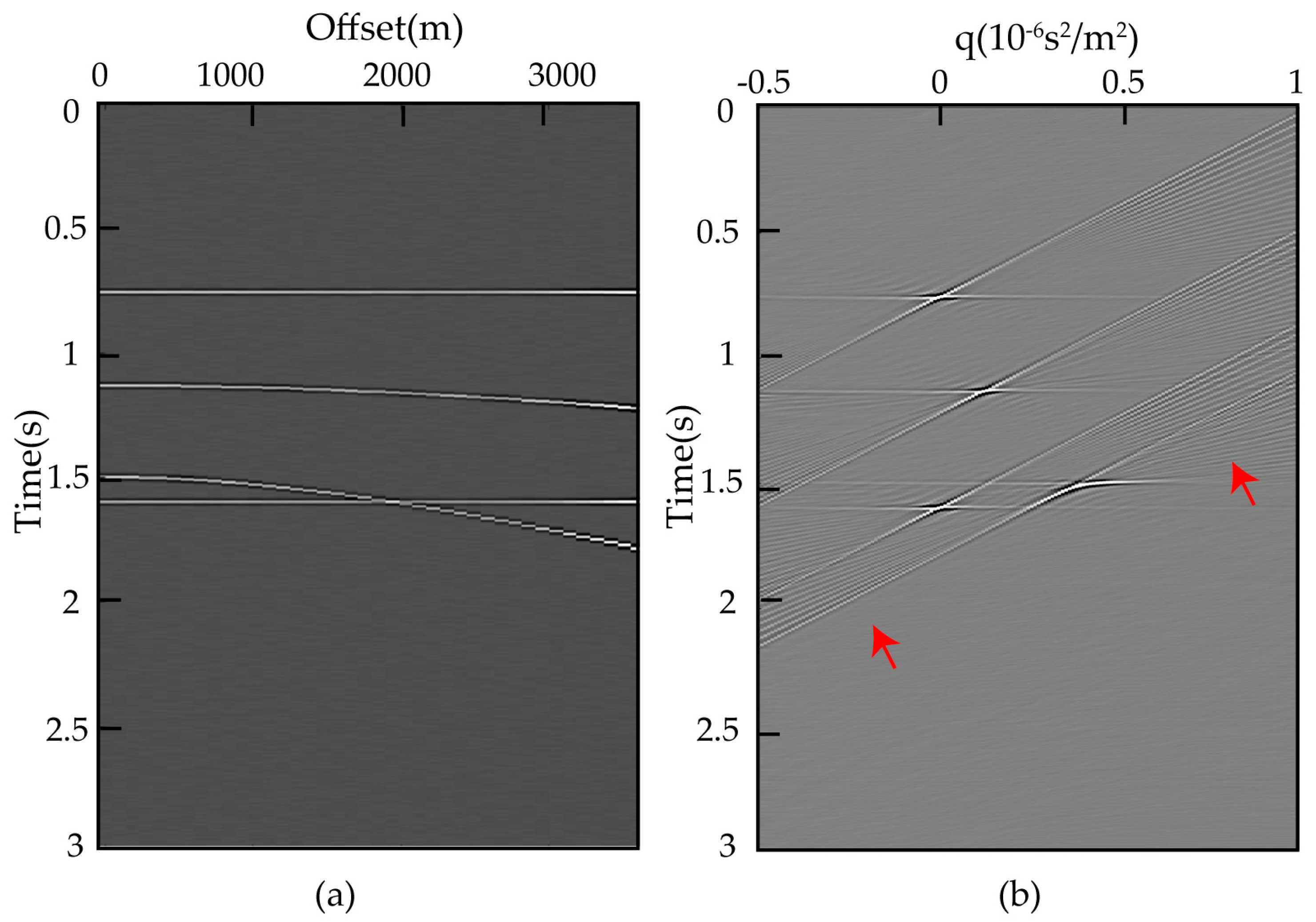

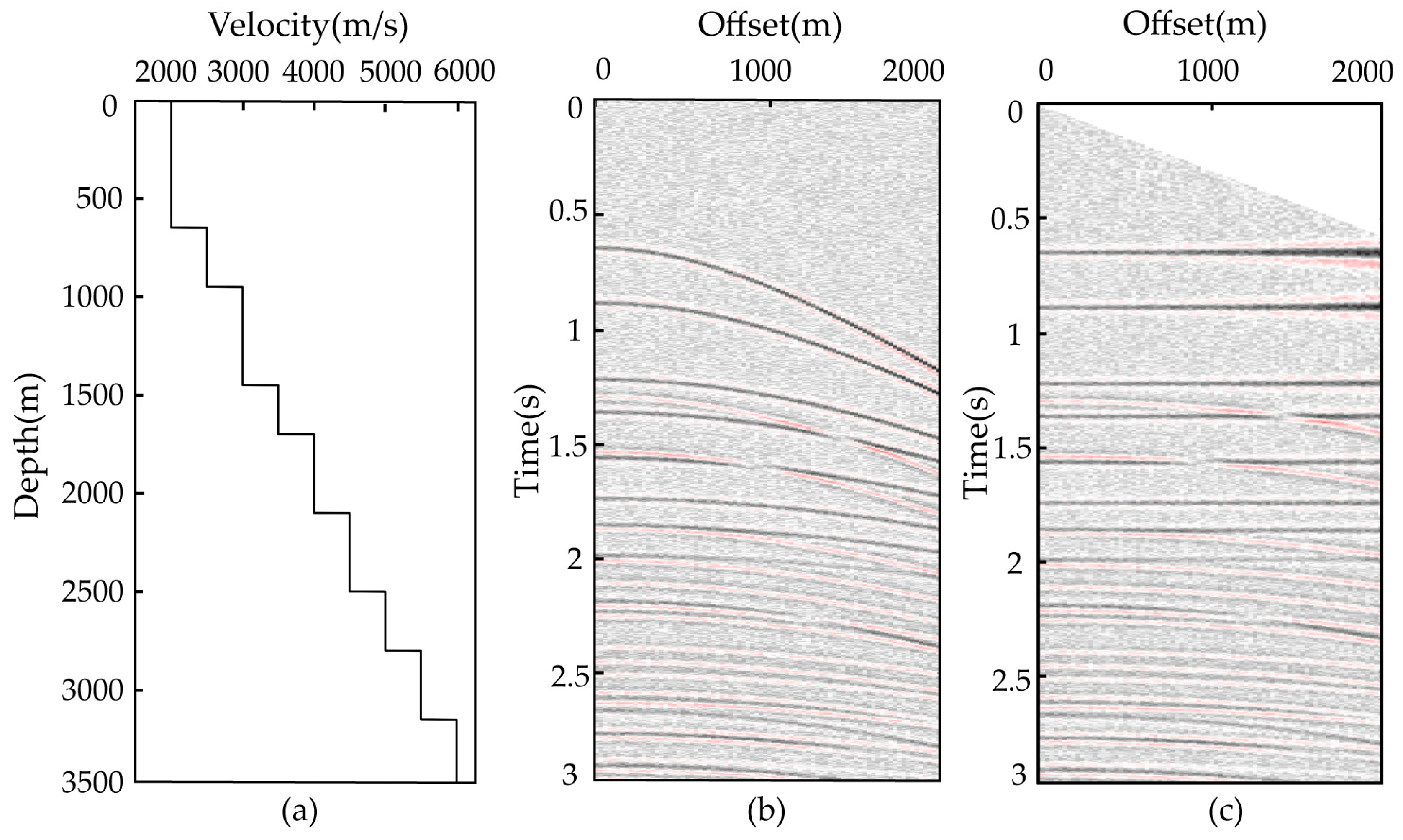
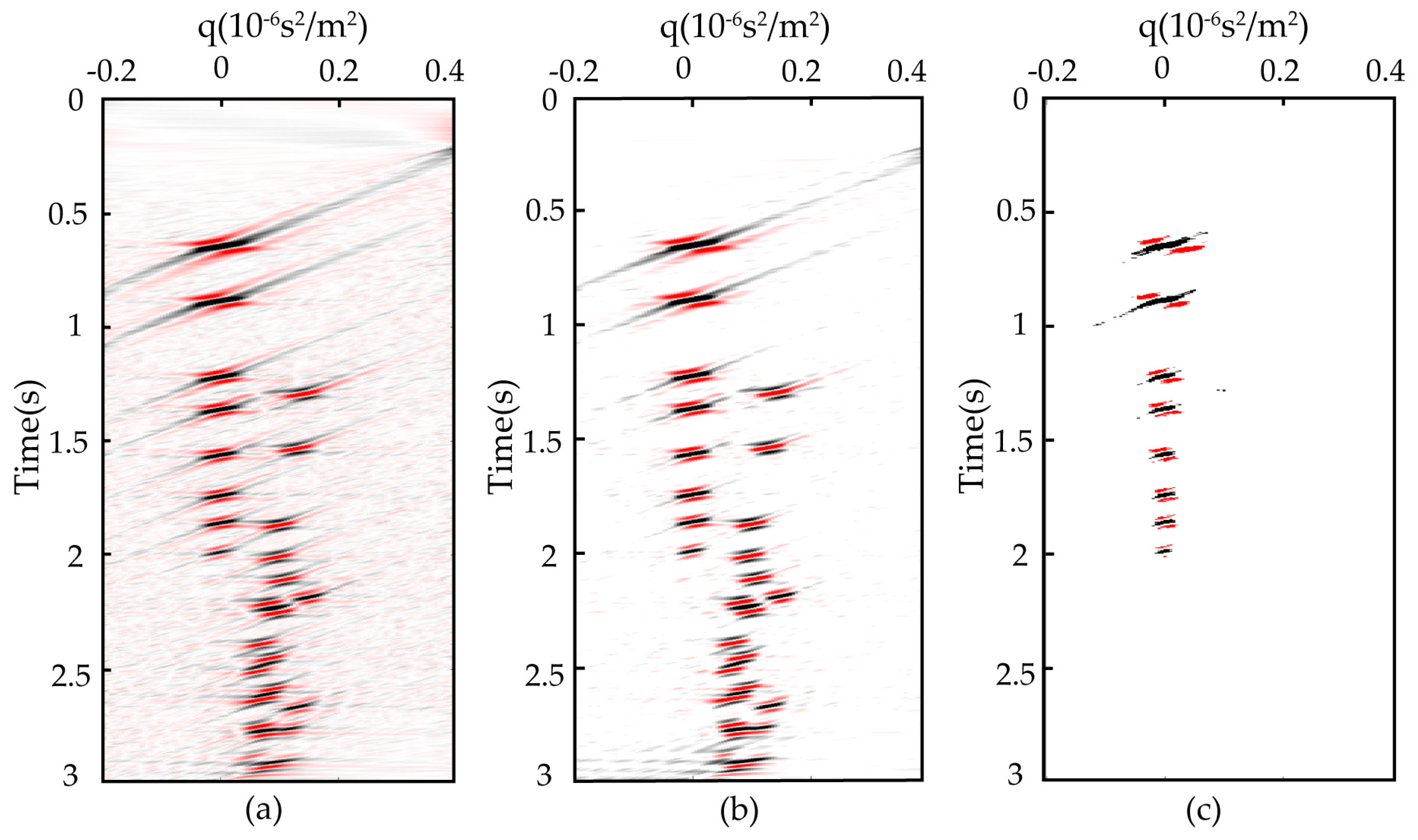
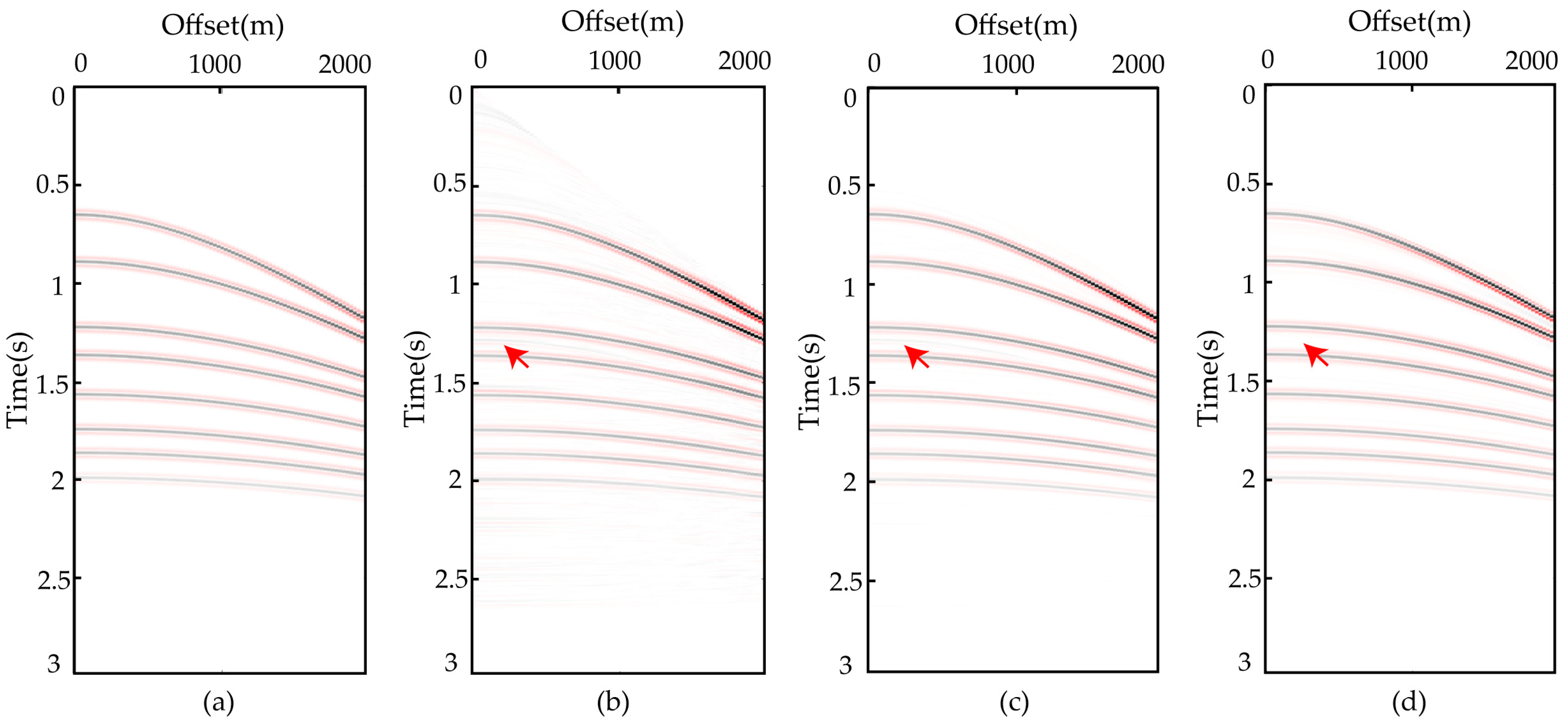

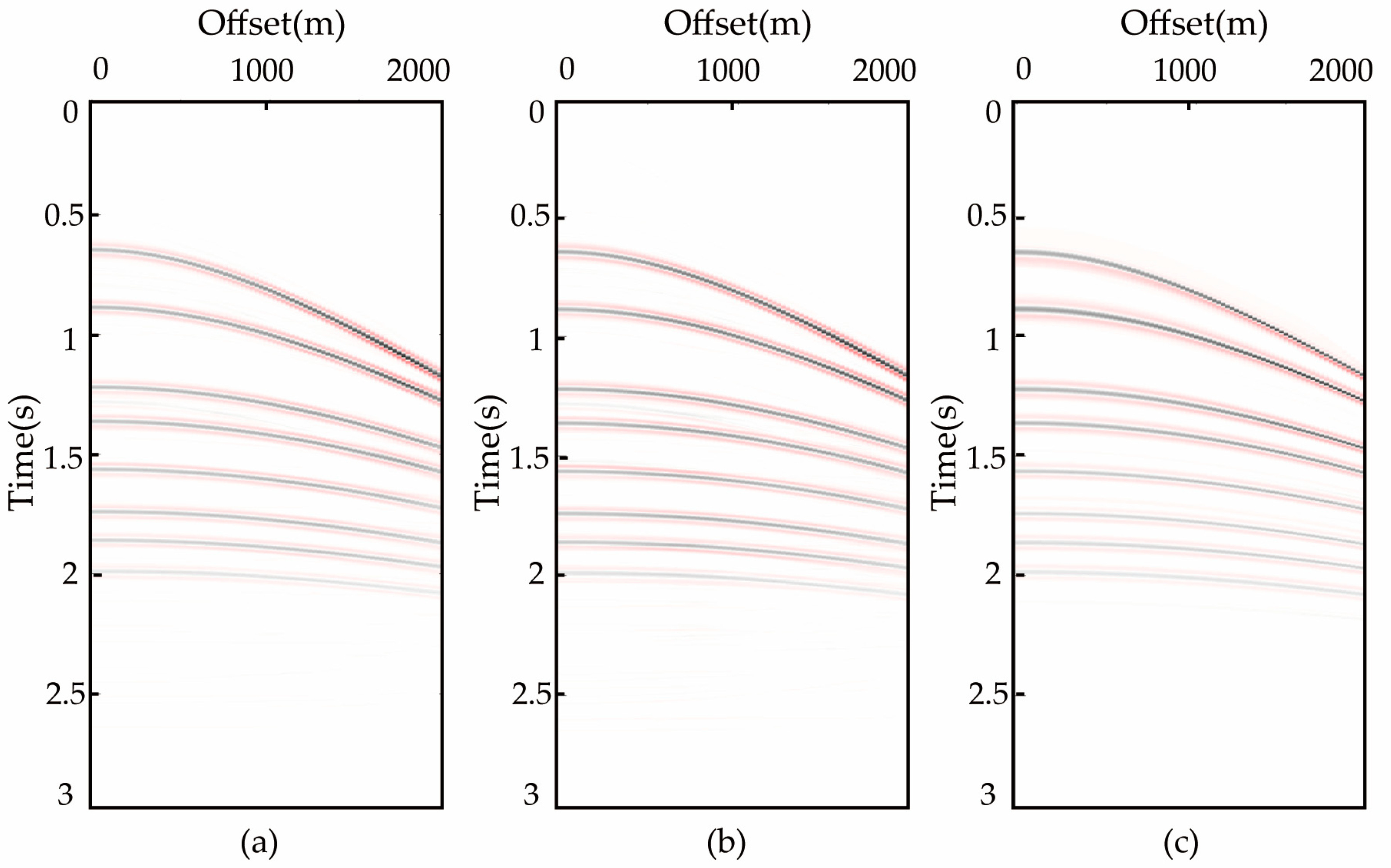
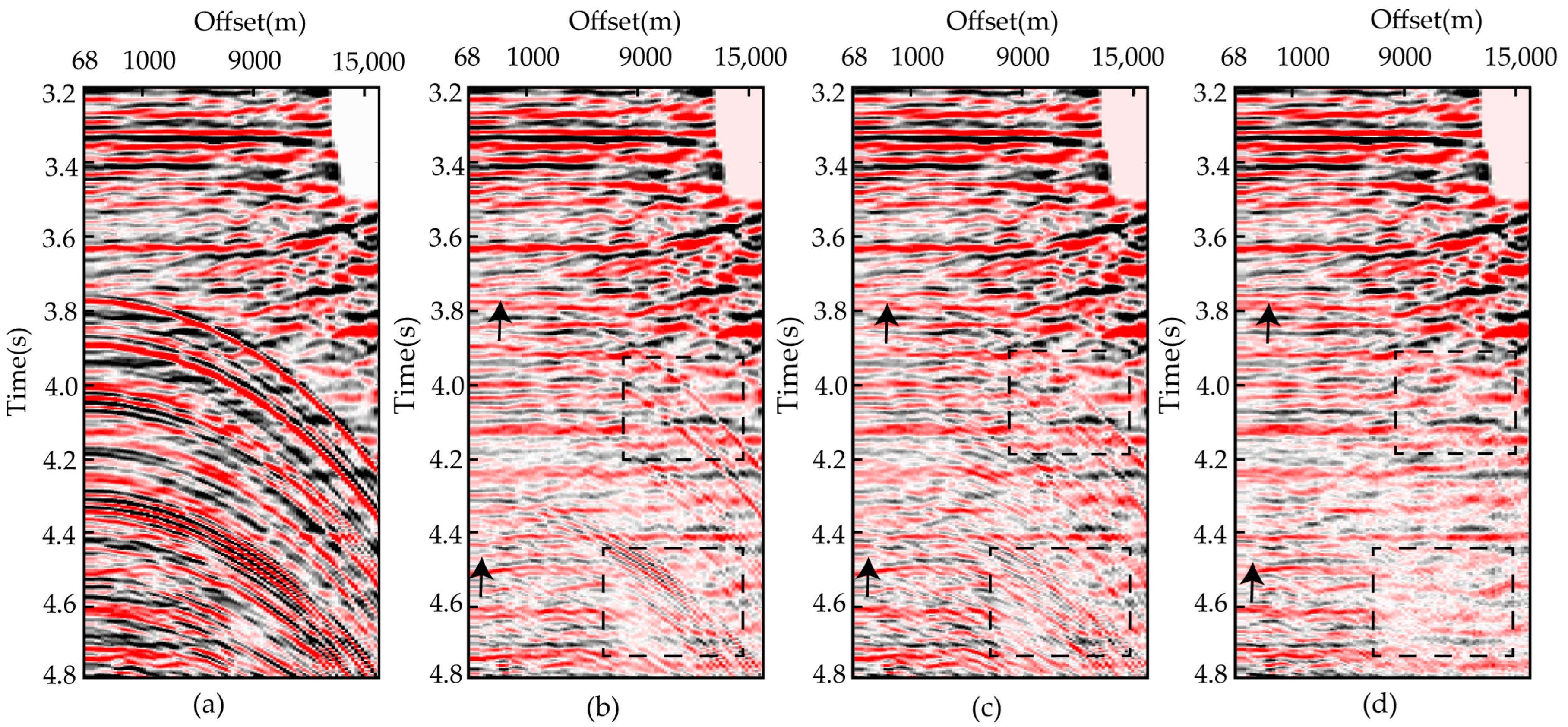

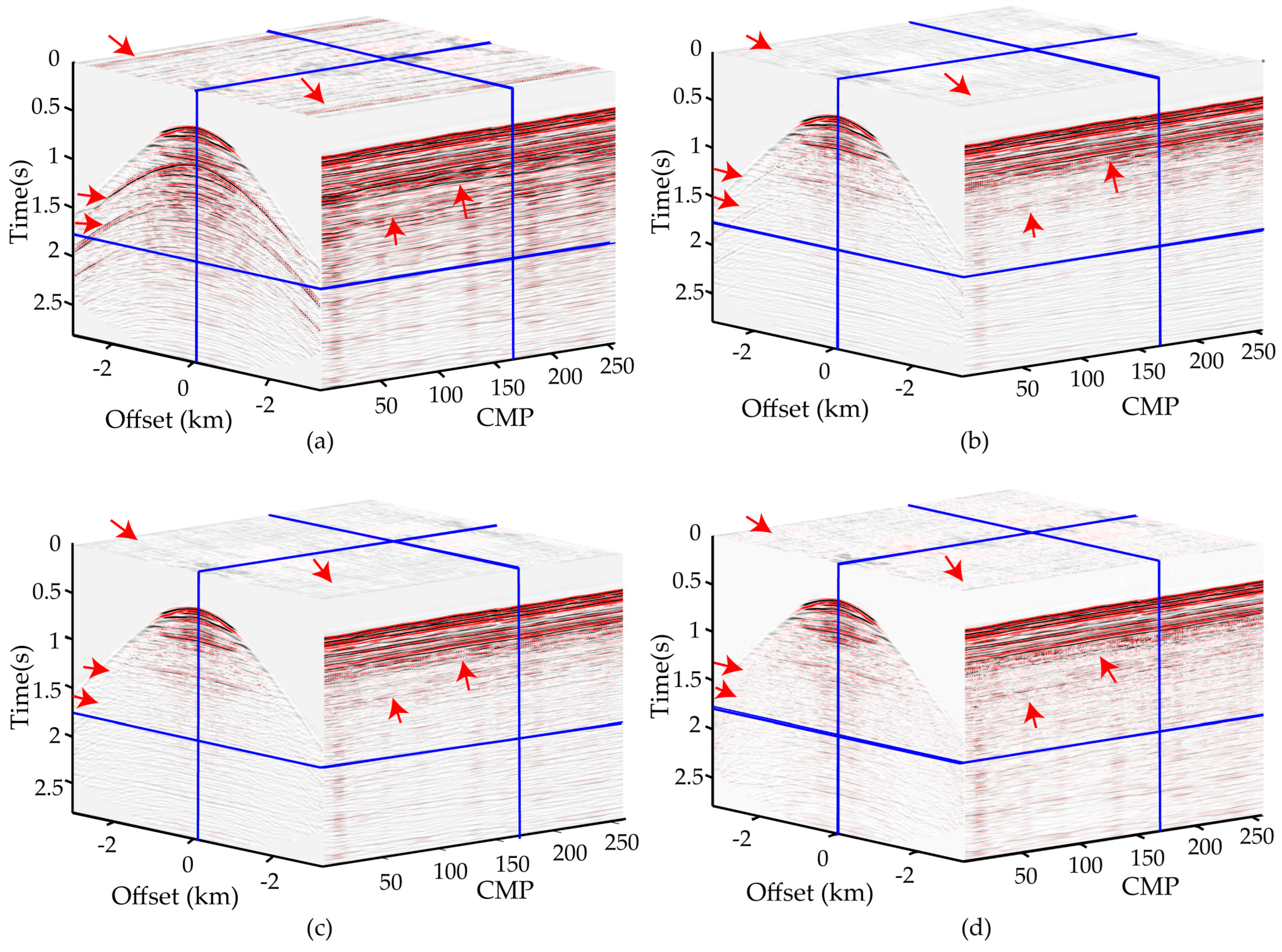
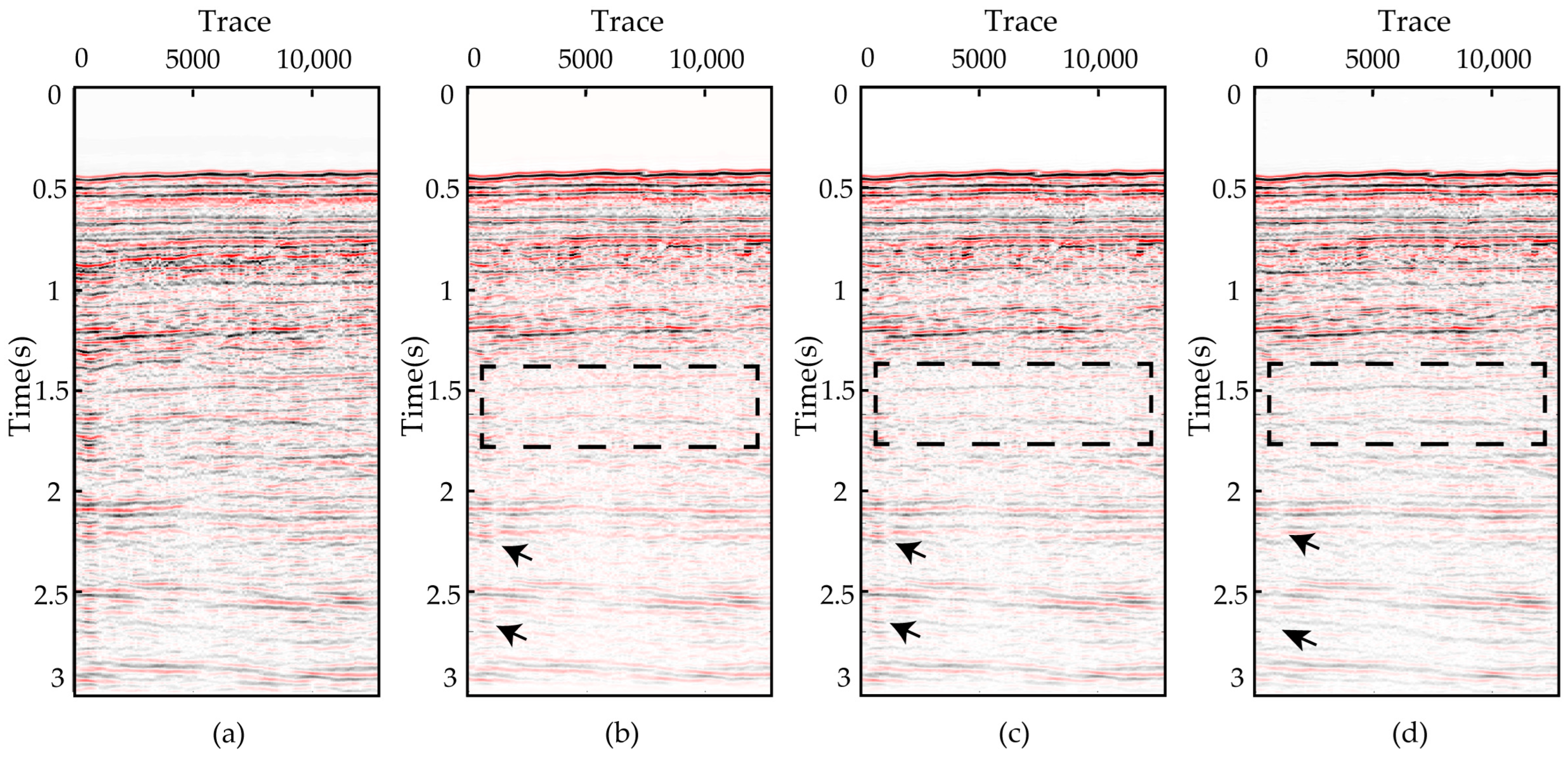
| Method | LSPRT | SPRTL1 | SPRTLq1 − Lq2 |
|---|---|---|---|
| Reconstruction error | 11.2% | 8.3% | 7.6% |
Disclaimer/Publisher’s Note: The statements, opinions and data contained in all publications are solely those of the individual author(s) and contributor(s) and not of MDPI and/or the editor(s). MDPI and/or the editor(s) disclaim responsibility for any injury to people or property resulting from any ideas, methods, instructions or products referred to in the content. |
© 2023 by the authors. Licensee MDPI, Basel, Switzerland. This article is an open access article distributed under the terms and conditions of the Creative Commons Attribution (CC BY) license (https://creativecommons.org/licenses/by/4.0/).
Share and Cite
Wu, Q.; Hu, B.; Liu, C.; Zhang, J. Sparse Parabolic Radon Transform with Nonconvex Mixed Regularization for Multiple Attenuation. Appl. Sci. 2023, 13, 2550. https://doi.org/10.3390/app13042550
Wu Q, Hu B, Liu C, Zhang J. Sparse Parabolic Radon Transform with Nonconvex Mixed Regularization for Multiple Attenuation. Applied Sciences. 2023; 13(4):2550. https://doi.org/10.3390/app13042550
Chicago/Turabian StyleWu, Qiuying, Bin Hu, Cai Liu, and Junming Zhang. 2023. "Sparse Parabolic Radon Transform with Nonconvex Mixed Regularization for Multiple Attenuation" Applied Sciences 13, no. 4: 2550. https://doi.org/10.3390/app13042550





